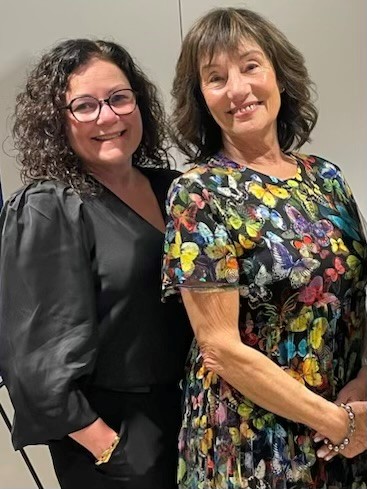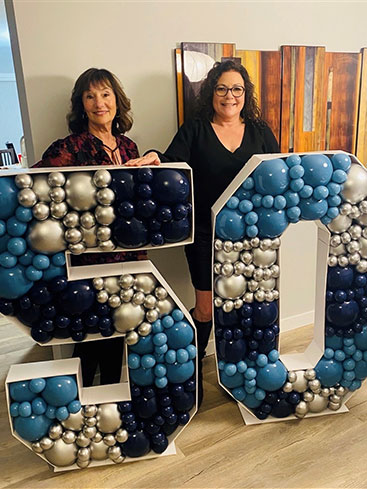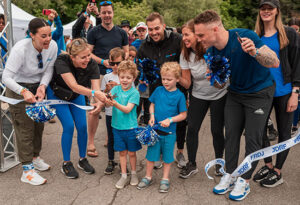

Myrna Weiszner, one of the founders of the JDRF Winnipeg chapter and her daughter Tammy, diagnosed with type 1 diabetes (T1D) 47 years ago talk about how living with T1D has changed over the years, and their involvement with JDRF.
Do you remember what it was like when Tammy was diagnosed?
Myrna – It was very scary; I was such a young mom. I was just in my early 20s. Tammy was just a toddler. It was spring and Tammy was outside playing and continuously drinking copious amounts of water and not making it to the bathroom. I recall reprimanding her about not attending to the bathroom sooner. Tammy’s dad had type 1 diabetes and it clicked that I should test her urine. At the time, the only way to test was via urine testing. Sure enough, her sugar was elevated. We were living in a small community, and we rushed into Winnipeg. We arrived at midnight, and she was admitted to Children’s Hospital.
At that time, parents were not permitted to spend the night with their child in the hospital. When I look back, what a brave little girl, at 4 years old. We were permitted to return at 7am and promptly we did.
When we arrived at 7am, Tammy informed us she was given insulin at 3am.
I was so distraught; I didn’t even remember it was Mother’s Day. I was told Tammy would not be discharged until I could administer an injection. The thought of giving Tammy a needle was very difficult for me therefore I had to practice on an orange. They reiterated Tammy would not be discharged until I could give her an injection. I knew I had to do it therefore I learned. Reflecting, giving her insulin never got easier, I continuously struggled. When Tammy was 6 years old, I think she wanted to show that she was a big girl now – she gave herself insulin and never looked back.
Tammy – I don’t remember much about the diagnosis; I was 4 years old and I’m 51 this year. I remember urine testing, the tablet fizzing in the test tube waiting for it to change colour. The darker the colour, the higher the sugar. This was completely inaccurate and, reflecting, I don’t know how I survived. I was four years old, and we had to take a potty with us for a urine test, everywhere we went. However, this was all that was available at that time, and therefore we made do. I remember the diet being very restrictive and life was quite regimented.
Even corn flakes (cereal) was considered to be too high in sugar to eat. Although I have adapted and adopted the most recent technology, I cannot let go of the routine. When I was growing up (with T1D), I ate relatively the same thing every day at the same time. I took the same amount of insulin, which was (called at the time) Regular and it took forever to work.
Myrna – and if Tammy’s sugar was high, we had to exercise. Walking became a regular mode of exercise for our family.
Tammy – I remember drinking a can of pop thinking it was sugar-free however it was not. The only way to bring down my blood sugar was to exercise therefore I moved all the firewood from the garage to the basement, just trying to lower my sugar.
I had found my thighs to be the best place to inject insulin however I now have bumps, which is scar tissue from repeated injections in the same site. Needless to say, now I rotate my sites.
Myrna – When Tammy started kindergarten, I was so nervous. What would happen if her sugar was low? Tammy was the only child in the entire school that had T1D, and the teachers knew nothing about diabetes. I had to feel confident that Tammy would be able to recognize a low and treat it accordingly. One morning I remained at the school longer than usual, and the teacher asked me “do you see any other parents hanging around my door. School ends at 3pm”. Needless to say, I am still scarred by her lack of empathy.
Myrna – Once Tammy was on the school bus, and a boy told everyone that Tammy had diabetes and she was contagious. Therefore, even her closest friend did not let Tammy sit next to her. The bus driver told Tammy she needed to find a seat otherwise they couldn’t leave. Tammy ended up sitting with the patrol in the first seat. She arrived home sobbing. After hearing what had occurred, I called her best friend’s mother to notify her. I expected her to discuss the situation with her daughter, instead, she said “well Myrna, Tammy is going to be living with diabetes for a long time, so she better get used it”.
I learned a lesson too; kindness and understanding should not be taken for granted.
Myrna – Tammy was once with a babysitter, she was low (hypoglycemic), so they called an ambulance. We were still living in the small town then, and the hospital gave her glucose, and it was too much and ended up sending her (blood glucose levels) sky high. So, we took her by the hand and walked her around the town, we just walked and walked – and she must have felt terrible with these sugar swings, but we did what we had to do.
How life has changed for those with type 1 diabetes today! Thanks to JDRF’s accomplishments.
How did JDRF come into your lives?
Myrna – Mitch and Jimmy Garfinkle came to Winnipeg and gave us a talk about JDRF, and it just sounded phenomenal. They talked about research, and it gave me hope. I thought – my daughter isn’t going to live long enough without T1D research. There wasn’t much known about T1D at all (then). Four couples got together and formed the Winnipeg chapter and here we are.
Our first fundraiser was Pearl and Earl Kaplan, one of the other founding families (they had a grandchild with T1D), who celebrated a special anniversary and in lieu of gifts, they requested donations to JDRF.
Tammy – Darrin Davis (son of another Winnipeg founding family) was the only other person with T1D I knew back then.
How has T1D management changed over the years?
Tammy – Today I use a continuous glucose monitor, the Dexcom 7 and the Omnipod dash (insulin pump). Growing up, my parents often reminded me, that Darrin Davis used a pump and how great it was. For whatever reasons, I still wasn’t ready. Around 2005, I finally decided to give a pump a try. It was the animus tubed pump. I was receiving insulin 24 hours a day with the push of a button.
As revolutionary as it was, the CGM in my opinion, has proved to be monumental in managing T1D. Before the CGM, we knew nothing about what was going on in our bodies, really.
When you were a child back then with T1D, you got your hemoglobin A1C tested every three months or so, and showed a notebook of blood sugars to the doctor for them to assess and make adjustments as needed. Now I can assess trends, promptly make adjustments, review history. Overall, I can be proactive instead of reactive. I often think of newly diagnosed children and how different their lives will be as a result of the advancements and knowledge in managing T1D.
Managing T1D has significantly changed and greatly improved the quality of life and outcomes for individuals living with T1D compared to 50 years ago.
But despite these advancements, daily challenges remain.
What has JDRF meant to you both?
Myrna – JDRF has been a beacon of light and is like family to me. The volunteers, support staff, brilliant researchers, donors and contributors have made JDRF what it is today. JDRF has made significant contributions to improving the lives of people living with diabetes by funding research for better treatment, technology and ultimately a cure.
Tammy – the correct terminology is, you aren’t a diabetic, you have diabetes. But truly, diabetes is my life. If there was a cure – I really can’t even imagine it. It would be life-altering. I spent my teenage years wondering about ‘will I make it to adulthood, and how will it be?’, then I hit adulthood and wondered what middle-age might look like having T1D. Now I am 50, and I worry about the potential T1D complications I could experience. Each period of my life, I have experienced different thoughts and worries. Just the idea of not having to worry anymore would be remarkable. Because of JDRF, I look forward to new technology and improvements in managing T1D. Screening for and preventing new diagnoses would also be amazing. If a cure is discovered in my lifetime, what a miracle it will be. However, in the meantime, I will just continue to live my best life.
Myrna – it was so encouraging and hopeful walking through the labs where JDRF-funded research was conducted. JDRF has played a crucial role in enhancing the quality of life of individuals throughout the world living with T1D.




